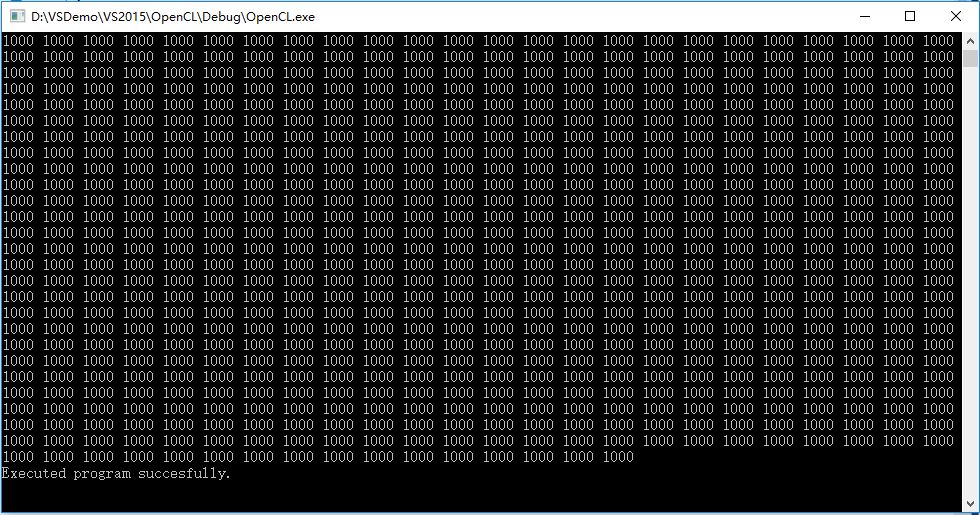1. 选择OpenCL平台并创建一个上下文
平台(Platform)是指主机和OpenCL管理框架下的若干个设备构成的可以运行OpenCL程序的完整硬件系统,这个是跑OpenCL程序的基础,所以第一步要选择一个可用的OpenCL品台。一台机器上可以有不止一个这样的品台,一个平台也可以有不止一个GPU。
主要涉及的函数: clGetPlatformIDs() ,用于获取可用的平台;
clCreateContextFromType(), 创建一个OpenCL运行时山下文环境;
2. 选择设备并创建命令队列
选择平台并创建好OpenCL上下文环境之后,要做的事选择运行时用到的设备,还要创建一个命令队列,命令队列里定义了设备要完成的操作,以及各个操作的运行次序。
主要涉及的函数:clCreateCommandQueue(),用于创建一个指定设备上的上下文环境,第二个参数定义了选择的设备。
3. 创建和构建程序对象
程序对象用来存储与上下文相关联的设备的已编译可执行代码,同时也完成内核源代码的加载编译工作。
主要涉及的函数:clCreateProgramWithSource(), 这个函数会创建一个程序对象,在创建的同时,把已经转化成字符串形式的内核源代码加载到该程序对象中。
clBuildProgram()用于编译指定程序对象中的内核源代码,编译成功之后,再把编译代码存储在程序对象中。
4. 创建内核和内存对象
要执行程序对象中的已编译成功的内核运算,需要在内存中创建内核并分配内核函数的参数,在GPU上定义内存对象并分配存储空间。
主要涉及的函数:clCreateKernel(), 创建内核;
clCreateBuffer(),分配内存对象的存储空间,这些对象可以由内核函数直接访问。
5. 设置内核数据并执行内核
创建内核和内存对象之后,接下来要设置核函数的数据,并将要执行的内核排队。
主要涉及的函数:clEnqueueNDRangeKernel(),用于设置内核函数的所有参与运算的数据。 利用命令队列对要在设备上执行的内核排队。需要注意的是,执行内核排队之后并不意味着这个内核一定会立即执行,只是排队到了执行队列中。
6. 读取执行结果并释放OpenCL资源
内核执行完成之后,需要把数据从GPU拷贝到CPU中,供主机进一步处理,所有者写工作完成之后需要释放所有的OpenCL资源。
主要涉及的函数:clEnqueueReadBuffer(),读取设备内存数据到主机内存;
clReleaseXXX(),释放OpenCL资源。
以下程序包含了以上所有6个步骤,功能很简单,实现两个数组求和。
主程序:
#include <iostream>
#include <fstream>
#include <sstream>
#include <CL/cl.h>
const int ARRAY_SIZE = 1000;
//一、 选择OpenCL平台并创建一个上下文
cl_context CreateContext()
{
cl_int errNum;
cl_uint numPlatforms;
cl_platform_id firstPlatformId;
cl_context context = NULL;
//选择可用的平台中的第一个
errNum = clGetPlatformIDs(1, &firstPlatformId, &numPlatforms);
if (errNum != CL_SUCCESS || numPlatforms <= 0)
{
std::cerr << "Failed to find any OpenCL platforms." << std::endl;
return NULL;
}
//创建一个OpenCL上下文环境
cl_context_properties contextProperties[] =
{
CL_CONTEXT_PLATFORM,
(cl_context_properties)firstPlatformId,
0
};
context = clCreateContextFromType(contextProperties, CL_DEVICE_TYPE_GPU,
NULL, NULL, &errNum);
return context;
}
//二、 创建设备并创建命令队列
cl_command_queue CreateCommandQueue(cl_context context, cl_device_id *device)
{
cl_int errNum;
cl_device_id *devices;
cl_command_queue commandQueue = NULL;
size_t deviceBufferSize = -1;
// 获取设备缓冲区大小
errNum = clGetContextInfo(context, CL_CONTEXT_DEVICES, 0, NULL, &deviceBufferSize);
if (deviceBufferSize <= 0)
{
std::cerr << "No devices available.";
return NULL;
}
// 为设备分配缓存空间
devices = new cl_device_id[deviceBufferSize / sizeof(cl_device_id)];
errNum = clGetContextInfo(context, CL_CONTEXT_DEVICES, deviceBufferSize, devices, NULL);
//选取可用设备中的第一个
commandQueue = clCreateCommandQueue(context, devices[0], 0, NULL);
*device = devices[0];
delete[] devices;
return commandQueue;
}
// 三、创建和构建程序对象
cl_program CreateProgram(cl_context context, cl_device_id device, const char* fileName)
{
cl_int errNum;
cl_program program;
std::ifstream kernelFile(fileName, std::ios::in);
if (!kernelFile.is_open())
{
std::cerr << "Failed to open file for reading: " << fileName << std::endl;
return NULL;
}
std::ostringstream oss;
oss << kernelFile.rdbuf();
std::string srcStdStr = oss.str();
const char *srcStr = srcStdStr.c_str();
program = clCreateProgramWithSource(context, 1,
(const char**)&srcStr,
NULL, NULL);
errNum = clBuildProgram(program, 0, NULL, NULL, NULL, NULL);
return program;
}
//创建和构建程序对象
bool CreateMemObjects(cl_context context, cl_mem memObjects[3],
float *a, float *b)
{
memObjects[0] = clCreateBuffer(context, CL_MEM_READ_ONLY | CL_MEM_COPY_HOST_PTR,
sizeof(float) * ARRAY_SIZE, a, NULL);
memObjects[1] = clCreateBuffer(context, CL_MEM_READ_ONLY | CL_MEM_COPY_HOST_PTR,
sizeof(float) * ARRAY_SIZE, b, NULL);
memObjects[2] = clCreateBuffer(context, CL_MEM_READ_WRITE,
sizeof(float) * ARRAY_SIZE, NULL, NULL);
return true;
}
// 释放OpenCL资源
void Cleanup(cl_context context, cl_command_queue commandQueue,
cl_program program, cl_kernel kernel, cl_mem memObjects[3])
{
for (int i = 0; i < 3; i++)
{
if (memObjects[i] != 0)
clReleaseMemObject(memObjects[i]);
}
if (commandQueue != 0)
clReleaseCommandQueue(commandQueue);
if (kernel != 0)
clReleaseKernel(kernel);
if (program != 0)
clReleaseProgram(program);
if (context != 0)
clReleaseContext(context);
}
int main(int argc, char** argv)
{
cl_context context = 0;
cl_command_queue commandQueue = 0;
cl_program program = 0;
cl_device_id device = 0;
cl_kernel kernel = 0;
cl_mem memObjects[3] = { 0, 0, 0 };
cl_int errNum;
// 一、选择OpenCL平台并创建一个上下文
context = CreateContext();
// 二、 创建设备并创建命令队列
commandQueue = CreateCommandQueue(context, &device);
//创建和构建程序对象
program = CreateProgram(context, device, "HelloWorld.cl");
// 四、 创建OpenCL内核并分配内存空间
kernel = clCreateKernel(program, "hello_kernel", NULL);
//创建要处理的数据
float result[ARRAY_SIZE];
float a[ARRAY_SIZE];
float b[ARRAY_SIZE];
for (int i = 0; i < ARRAY_SIZE; i++)
{
a[i] = (float)i;
b[i] = (float)(ARRAY_SIZE - i);
}
//创建内存对象
if (!CreateMemObjects(context, memObjects, a, b))
{
Cleanup(context, commandQueue, program, kernel, memObjects);
return 1;
}
// 五、 设置内核数据并执行内核
errNum = clSetKernelArg(kernel, 0, sizeof(cl_mem), &memObjects[0]);
errNum |= clSetKernelArg(kernel, 1, sizeof(cl_mem), &memObjects[1]);
errNum |= clSetKernelArg(kernel, 2, sizeof(cl_mem), &memObjects[2]);
size_t globalWorkSize[1] = { ARRAY_SIZE };
size_t localWorkSize[1] = { 1 };
errNum = clEnqueueNDRangeKernel(commandQueue, kernel, 1, NULL,
globalWorkSize, localWorkSize,
0, NULL, NULL);
// 六、 读取执行结果并释放OpenCL资源
errNum = clEnqueueReadBuffer(commandQueue, memObjects[2], CL_TRUE,
0, ARRAY_SIZE * sizeof(float), result,
0, NULL, NULL);
for (int i = 0; i < ARRAY_SIZE; i++)
{
std::cout << result[i] << " ";
}
std::cout << std::endl;
std::cout << "Executed program succesfully." << std::endl;
getchar();
Cleanup(context, commandQueue, program, kernel, memObjects);
return 0;
}
核函数文件“HelloWorld.cl”:
__kernel void hello_kernel(__global const float *a,
__global const float *b,
__global float *result)
{
int gid = get_global_id(0);
result[gid] = a[gid] + b[gid];
}
执行结果:




